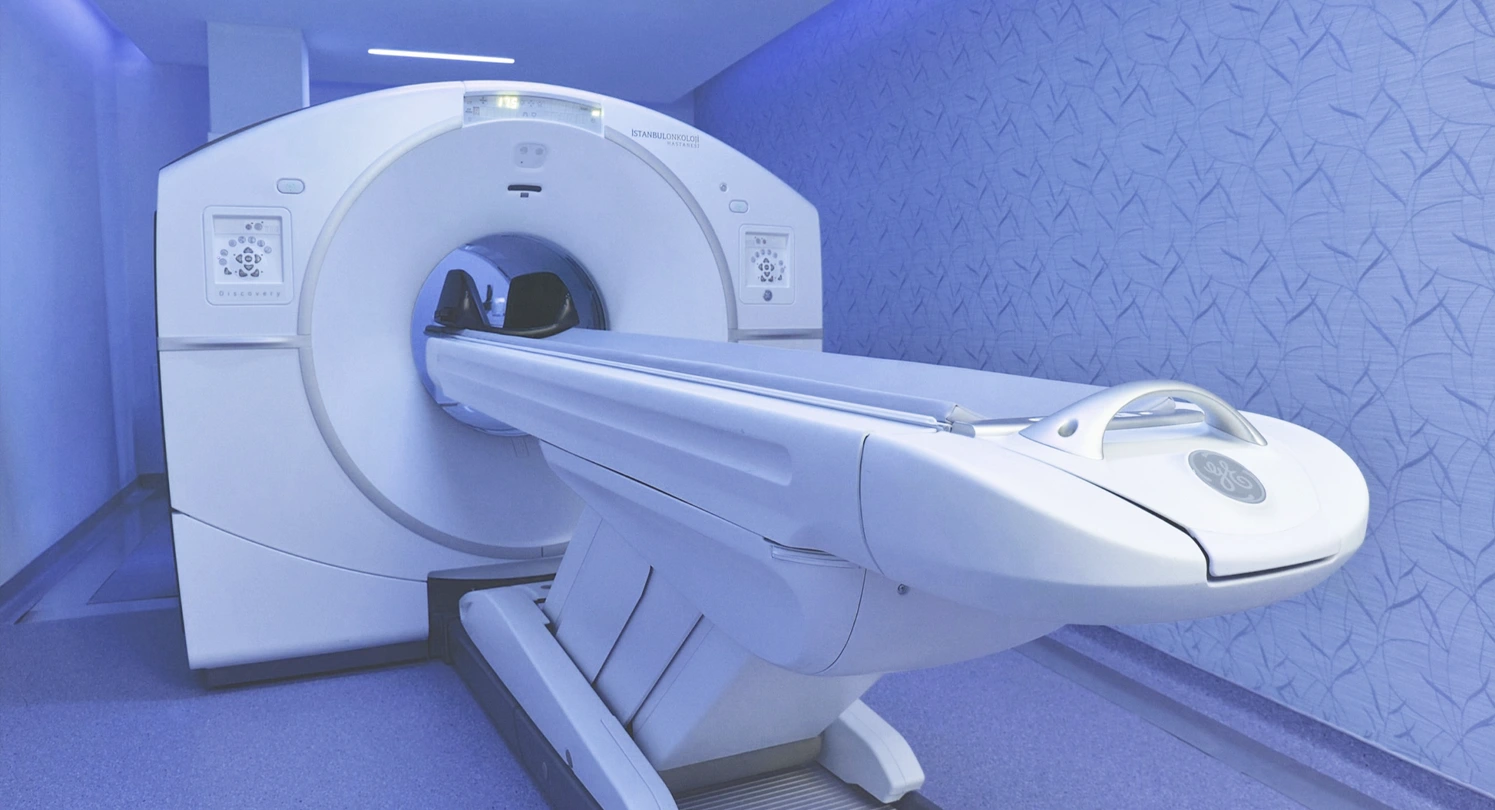FDG PET-CT
In our Nuclear Medicine Department, we both use diagnostic and therapeutic procedures using radioactive materials called radiopharmaceuticals.
What diagnostic procedures are performed in the Nuclear Medicine Department?
- FDG-PET (Fluorodeoxyglucose PET)
FDG-PET is a pelvic imaging modality for cancer imaging assisting in the diagnosis and staging of patients with newly diagnosed malignancy or restaging following therapy and surveillance.
The radiopharmaceutical called fluorodeoxyglucose (FDG), which is the radioactive form of glucose, is used in this imaging procedure. The role of this procedure is to detect metabolically active malignant lesions in many types of cancers, including lung cancer, colorectal cancer, breast cancer, lymphoma, melanoma, ovarian cancer, and multiple myeloma.
- Ga-68 DOTATATE PETCT
Ga-68 DOTATATE PETCT is a type of scan utilized to diagnose and monitor, especially neuroendocrine tumors, which involve both the nervous system and endocrine glands. A special radioactive tracer called Ga-68 DOTATATE is injected intravenously. It binds somatostatin receptors and provides important characteristics of the disease.
- Ga-68 PSMA PETCT (Prostate-Specific Membrane Antigen PETCT)
Ga-68 PSMA-PETCT is a specialized imaging technique in the diagnosis and staging of prostate cancer. It targets prostate-specific membrane antigen receptors on prostate cancer cells.
For more information and a medical evaluation, please complete the form to contact us.
What are the benefits of a PET-CT scan?
Detect Cancer: PET-CT scans are highly effective in identifying cancerous lesions, even in their early stages, by highlighting areas of increased metabolic activity.
Stage Cancer: PET-CT scans play a crucial role in determining the extent and stage of cancer by revealing whether it has spread to other parts of the body.
Monitor Treatment: PET-CT scans provide the ability to assess the effectiveness of cancer treatments, such as chemotherapy or radiation therapy, by tracking changes in cell activity over time.
Plan Surgery and Radiation Therapy: By offering detailed anatomical information, PET-CT scans aid in surgical planning and the precise targeting of radiation therapy, contributing to improved treatment outcomes.
Evaluate Recurrence: PET-CT scans are instrumental in detecting areas of higher metabolic activity that may indicate the presence of cancer cells after treatment, facilitating the identification of cancer recurrence.
What are the preparations for the PET-CT scan?
Fasting: It is essential to fast, which means avoiding food and drink (except for water) for at least 6 hours before the test.
Blood Sugar Control: For individuals with diabetes, maintaining proper blood sugar levels is crucial. Elevated blood sugar levels can interfere with the uptake of the radioactive tracer used in the scan.
Wear Comfortable Clothing: It is advisable to wear loose, comfortable clothing without any metal objects such as zippers, snaps, or underwire bras. You may be asked to change into a hospital gown if your dress contains metal.
Empty Bladder: You may be instructed to empty your bladder before the scan. This helps reduce the risk of artifacts in the images and ensures a more precise and more accurate examination.
How long does a PET-CT scan take?
A PET-CT scan typically takes about 75 to 120 minutes to complete, considering the time for injection, waiting, and the scanning period.
How is a PET-CT Scan performed?
- Radiotracer Injection: Before the scan, you will receive a small amount of a radioactive substance, usually a type of sugar called FDG (fluorodeoxyglucose). Your body’s cells, including cancer cells, absorb this radioactive tracer, emitting positrons that the PET scanner can detect.
- Waiting Period: After receiving the injection, there is a waiting period of about 45 to 60 minutes. This allows the tracer to distribute throughout your body, concentrating in areas of higher metabolic activity.
- Scanning: You will be positioned on the PET scanner table. The scanner, a large, donut-shaped machine, will slowly move over the examined area. It is crucial to remain on the table during the scan to ensure accurate imaging.
What are the other types of PET imaging?
- DOTA PET: Also known as somatostatin receptor PET imaging, DOTA PET is primarily used to evaluate neuroendocrine tumors (NETs) and certain other medical conditions.
- Prostate-specific membrane antigen (PSMA) PET: PSMA PET is an advanced molecular imaging technique primarily used in diagnosing, staging, and monitoring prostate cancer. This method involves the use of radiopharmaceuticals targeting PSMA, a protein highly expressed on the surface of prostate cancer cells.
For which patients is a PET-CT scan performed?
A PET-CT scan is typically conducted in various scenarios and for different reasons. Some common strategies and reasons for undergoing a PET-CT scan include:
- Cancer Diagnosis and Staging
- Cardiovascular Assessment
- Neurological Conditions
- Endocrine and Metabolic Disorders
- Research and Clinical Trials.
What are the precautions after a PET-CT scan?
Hydration: Drink plenty of water after the scan to facilitate the flushing out of the radioactive tracer from your system.
Urination: Use the restroom frequently to aid in the elimination of the radioactive tracer from your body.
Contact with Others: Limit close contact with infants, young children, and pregnant women for a few hours after the scan to minimize potential radiation exposure.
Medications: Resume taking any medications you may have temporarily discontinued before the scan unless your healthcare provider instructs otherwise.

- Nuclear Medicine
- September 26, 2023
- Editör Admin

